

A paten or diskos is a small plate, used during the Mass. It is generally used during the liturgy itself, while the reserved sacrament are stored in the tabernacle in a ciborium.


A paten or diskos is a small plate, used during the Mass. It is generally used during the liturgy itself, while the reserved sacrament are stored in the tabernacle in a ciborium.
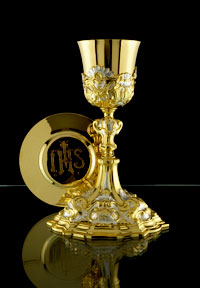
In many Western liturgical denominations, the paten is typically either a simple saucer-like plate or a low bowl. A smaller style paten will often have a depression that allows it to securely sit on top of the chalice, as shown in the illustration on the left here.
The General Instruction of the Roman Missal lays down rules for patens:
"Sacred vessels should be made from precious metal. If they are made from metal that rusts or from a metal less precious than gold, they should generally be gilded on the inside." [1]
However, provisions for vessels made from non-precious metals are made as well, provided they are "made from other solid materials which in the common estimation in each region are considered precious or noble." [2]
Some call the communion-plate a "paten", [3] but the English translation of the General Instruction of the Roman Missal approved by the English-speaking episcopal conferences and confirmed by the Holy See uses "communion-plate" to speak of this object (numbers 118 and 187) and reserves the term "paten" for the other object (numbers 84, 117, 141, etc.). [4] The two corresponding Latin terms are patina (communion-plate) and patena (paten). [5]
Patens are also used among Anglicans [6] and Lutherans. [7]
In the United Methodist Church, during the Order for the Ordination of Elders, each elder receives a stole, along with a chalice and paten, from the bishop after the part of the liturgy in which the bishop lays his hands and prays over the ministerial candidates. [8] This is because the newly ordained elders are now able to celebrate the Sacraments, such as Holy Communion. In the Methodist service of the Holy Communion, the bread is placed upon a paten during the offertory and once again after it consecrated, specifically following the fraction. The paten, along with the chalice, lies on the altar during the celebration of the Holy Eucharist. [9]

In the Byzantine Rite Eastern Orthodox and Byzantine Rite Catholic Churches, the paten is called a diskos [10] and is elevated by a stand (or "foot") permanently attached underneath. The diskos is usually more ornate than its Latin counterpart, and must always be made of gold or at least be gold-plated. The diskos may be engraved with an icon of Jesus Christ, the Nativity of Christ, the Cross, or most frequently the Theotokos.
When a diskos is made, it is usually accompanied by a matching asterisk (small, folding metal stand used to keep the Aër from disturbing the particles on the diskos), a spoon (for distributing Holy Communion to the faithful), and a spear (used to cut the Lamb during the Liturgy of Preparation).
For Christians of historically Eastern church families, the diskos symbolises the Ever-virgin Mary, who received God the Word into her womb and gave birth to him, as well as the Tomb of Christ, which received his body after the Crucifixion and from which he resurrected.
During the Divine Liturgy it is not only the Lamb (Host) that is placed on the diskos, but also particles to commemorate the Theotokos, the Saints, the living and the departed. Thus, on the diskos is represented the entire Church: the Church Militant and the Church Triumphant, arrayed around Christ. At the Great Entrance the deacon carries the Diskos, holding the foot of the diskos at his forehead. He then kneels at the side of the Holy Table, and the priest takes the diskos from him and places it on the Antimension. During the Anaphora, only the Lamb is consecrated.[ citation needed ]
At Holy Communion, the clergy partake of their portions of the Lamb directly from the diskos, but for the Communion of the faithful, the remainder of the Lamb is cut into small portions and placed in the chalice, from which the priest distributes Communion using the spoon. After Communion, the Deacon holds the diskos above the holy chalice and recites hymns of the Resurrection. Then he wipes the remaining particles (for the saints, living and departed) into the chalices saying the words:
"Wash away, O Lord, the sins of all those here commemorated, by Thy precious Blood, through the prayers of all Thy saints."[ citation needed ]
Sometimes, when a bishop celebrates the Liturgy, a smaller diskos is prepared for him with a small prosphoron from which he takes particles to commemorate the living and the departed before the Great Entrance.[ citation needed ]
During the Consecration of a Church, a diskos is used to hold the relics of the saints which will be sealed in the Holy Table and antimension by the bishop.
When a priest is ordained, a portion of the Lamb will be placed on a small diskos and given to him, as a sign of the Sacred Mysteries which are being entrusted to his care.
In the Russian tradition, there is a special liturgy of blessing used to sanctify a diskos before its first use at Liturgy. The diskos may be blessed separately or together in a set with the other sacred vessels. The blessing is normally done immediately before beginning of the Liturgy of Preparation, after which the priest carries the diskos into the sanctuary and begins the liturgy, using the newly blessed vessel in that Liturgy.
Up until the first time a diskos is used in the Divine Liturgy it is considered to be an ordinary vessel, and may be touched by anyone. However, after having been used in the Divine Liturgy, a diskos may be touched only by a deacon, priest or bishop. A subdeacon may touch the sacred vessels, but only if they are securely wrapped in cloth.
When not in use, the chalice, diskos, and all the sacred vessels should remain on the Table of Oblation (prothesis), wrapped in their cloth bags—either sitting on top and covered with a cloth, or stored securely in a cabinet built into the prothesis.
In the usage of the Alexandrian Rite, the diskos usually has a flat bottom with no foot. Additionally, it has a raised edge, forming a relatively high rim, preventing particles of the offered elements from falling to the floor.

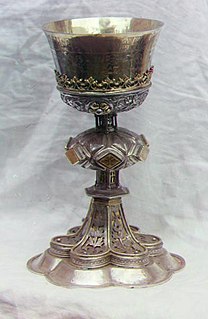
A chalice or goblet is a footed cup intended to hold a drink. In religious practice, a chalice is often used for drinking during a ceremony or may carry a certain symbolic meaning.
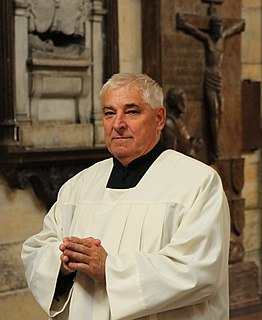
An altar server is a lay assistant to a member of the clergy during a Christian liturgy. An altar server attends to supporting tasks at the altar such as fetching and carrying, ringing the altar bell, helps bring up the gifts, brings up the book, among other things. If young, the server is commonly called an altar boy or altar girl. In some Christian denominations, altar servers are known as acolytes.

The antimins, is one of the most important furnishings of the altar in many Eastern Christian liturgical traditions. It is a rectangular piece of cloth of either linen or silk, typically decorated with representations of the Descent of Christ from the Cross, the Four Evangelists, and inscriptions related to the Passion. A small relic of a martyr is sewn into it.

The Liturgy of Preparation, also Prothesis or Proskomedia, is the name given in the Eastern Orthodox Church to the act of preparing the bread and wine for the Eucharist.
The Fraction or fractio panis is the ceremonial act of breaking the consecrated sacramental bread before distribution to communicants during the Eucharistic rite in some Christian denominations.
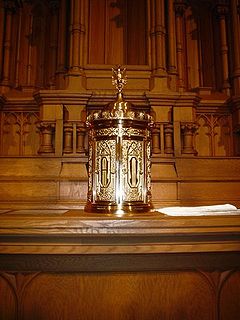
A tabernacle or sacrament house is a fixed, locked box in which the Eucharist is stored as part of the "reserved sacrament" rite. A container for the same purpose, which is set directly into a wall, is called an aumbry.

The Liturgy of the Presanctified Gifts is a Byzantine Rite liturgical service which is performed on the weekdays of Great Lent wherein communion is received from Gifts that are sanctified (consecrated) in advance, hence its name; this Divine Liturgy has no anaphora.

An altar cloth is used in the Christian liturgy to cover the altar. It serves as a sign of reverence as well as a decoration and a protection of the altar and the sacred vessels. In the orthodox churches is covered by the antimension, which also contains the relics of saints.

In the Roman Rite of the Catholic Church, Lutheranism, Methodism and Anglicanism, an altar bell is typically a small hand-held bell or set of bells. The primary reason for the use of such bells is to create a “joyful noise to the Lord” as a way to give thanks for the miracle taking place atop the altar.
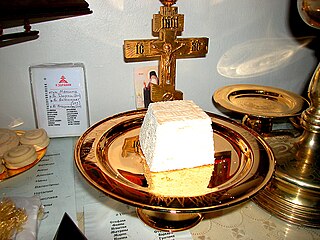
The Lamb is the square portion of bread cut from the prosphora in the Liturgy of Preparation at the Divine Liturgy in the Eastern Orthodox and Byzantine Catholic churches. The Lamb is cut from a specially prepared loaf of leavened bread and placed in the center of the diskos. The loaf, called a prosphoron, has had stamped in the top of its dough the seal of the Greek letters IC, XC, and NIKA, "Jesus Christ conquers", divided by a Greek cross, and the portion by the seal is cutout as the Lamb. The loaf must be made only from the finest flour, yeast, salt and water. It is formed in two layers to symbolize the hypostatic union.

During the Mass of the Faithful, the second part of the Mass, the elements of bread and wine are considered to have been changed into the veritable Body and Blood of Jesus Christ. The manner in which this occurs is referred to by the term transubstantiation, a theory of St. Thomas Aquinas, in the Roman Catholic Church. Members of the Orthodox, Anglican, and Lutheran communions also believe that Jesus Christ is really and truly present in the bread and wine, but they believe that the way in which this occurs must forever remain a sacred mystery. In many Christian churches some portion of the consecrated elements is set aside and reserved after the reception of Communion and referred to as the reserved sacrament. The reserved sacrament is usually stored in a tabernacle, a locked cabinet made of precious materials and usually located on, above, or near the high altar. In Western Christianity usually only the Host, from Latin: hostia, meaning "victim", is reserved, except where wine might be kept for the sick who cannot consume a host.

The Mass is the central liturgical rite in the Catholic Church, encompassing the Liturgy of the Word and the Liturgy of the Eucharist, where the bread and wine are consecrated and become the Body and Blood of Christ. As defined by the Church at the Council of Trent, in the Mass, "the same Christ who offered himself once in a bloody manner on the altar of the cross, is present and offered in an unbloody manner". The Church describes the Mass as the "source and summit of the Christian life". Thus the Church teaches that the Mass is a sacrifice. It teaches that the sacramental bread and wine, through consecration by an ordained priest, become the sacrificial body, blood, soul, and divinity of Christ as the sacrifice on Calvary made truly present once again on the altar. The Catholic Church permits only baptised members in the state of grace to receive Christ in the Eucharist.
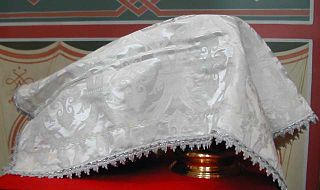
The Aër is the largest and outermost of the veils covering the Chalice and Diskos (paten) in the Eastern Orthodox Church and the Eastern Catholic Churches which follow the Byzantine Rite. It is rectangular in shape and corresponds to the veil used to cover the chalice and paten in the Latin liturgical rites, but is larger. It is often made of the same material and color as the vestments of the officiating priest, and often has a fringe going all the way around its edge. Tassels may also be sewn at each of the corners.

In Eastern and Western Christian liturgical practice, the elevation is a ritual raising of the consecrated Sacred Body and Blood of Christ during the celebration of the Eucharist. The term is applied especially to that by which, in the Catholic Roman Rite of Mass, the Sacred Body of Christ (Host) and the chalice containing the Most Precious Blood of Christ are each lifted up and shown to the congregation immediately after each is consecrated. The term may also refer to a musical work played or sung at that time.

Communion under both kinds in Christianity is the reception under both "species" of the Eucharist. Denominations of Christianity that hold to a doctrine of Communion under both kinds may believe that a Eucharist which does not include both bread and wine as elements of the religious ceremony is not valid, while others may consider the presence of both bread and wine as preferable, but not necessary, for the ceremony. In some traditions, grape juice may take the place of wine with alcohol content as the second element.
The Spear or Lance is a liturgical implement used during the Divine Liturgy in the Byzantine Rite of the Eastern Orthodox Church and the Eastern Catholic Churches.
The Spoon is a liturgical implement used to distribute Holy Communion to the laity during the Divine Liturgy in some Eastern Christian rites.

The Asterisk, or Star-cover, is one of the holy vessels used in the Divine Liturgy of the Eastern Orthodox, Oriental Orthodox and Eastern Catholic Churches. The asterisk symbolizes the Star of Bethlehem. Historically, it was also used in some parts of the Roman Catholic Church.

A credence table is a small side table in the sanctuary of a Christian church which is used in the celebration of the Eucharist..

A communion-plate is a metal plate held under the chin of a communicant while receiving Holy Communion in the Catholic Church. Its use was common in the last part of the nineteenth century and during most of the twentieth.
The supplemental document Living into the Mystery, which attends to more practical issues in our celebration of Holy Communion, provides additional guidance: The Lord’s Table should be set with “a plain white linen to cover the table, a chalice for the wine, and a paten (plate) for the bread. Some traditions in our church would add a plain white cloth to cover the chalice and paten as well.”